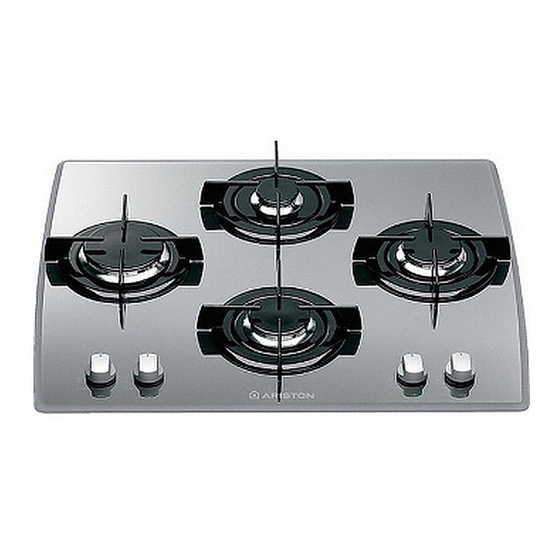Ariston CISTD 640 Series Руководство по эксплуатации - Страница 4
Просмотреть онлайн или скачать pdf Руководство по эксплуатации для Варочная панель Ariston CISTD 640 Series. Ariston CISTD 640 Series 14 страниц.
Также для Ariston CISTD 640 Series: Руководство по эксплуатации (20 страниц)

It is recommended that you follow the guidelines
below:
-
Only use the appliance to cook food, avoiding all other
uses;
-
Check the condition of the appliance after it has been
unpacked;
-
Disconnect the appliance from the power supply in the
event of malfunction and always before cleaning or
maintenance;
The following instructions are intended for the installer so
that the installation and maintenance procedures may be
followed in the most professional and expert manner
possible. Important: Disconnect the appliance from the
electrical supply before performing any maintenance
or regulation upkeep work.
Positioning the Cooktop
Important: this unit may be installed and used only in
permanently ventilated rooms in accordance with British
Standard Codes Of Practice: B.S. 6172 / B.S. 5440, Par.
2 and B.S. 6891 Current Editions. The following
requirements must be observed:
a) The room must be fitted with a ventilation system which
vents smoke and gases from combustion to the outside.
This must be done by means of a hood or electric
ventilator that turns on automatically each time the hood
is operated.
In a chimney stack or branched flue.
(exclusively for cooking appliances)
b) The room must also allow for the influx of the air needed
for proper combustion. The flow of air for combustion
purposes must not be less than 2 m³/h per kW of installed
capacity. The supply of said air can be effected by means
of direct influx from the outside through a duct with a
inner cross section of at least 100 cm² which must not be
able to be accidentally blocked. Those appliances which
are not fitted with a safety device to prevent the flame
from accidentally going out must have a ventilation
opening twice the size otherwise required, i.e. a minimum
of 200cm² (Fig. A). Otherwise, the room can be vented
indirectly through adjacent rooms fitted with ventilation
Installation Instructions for built-in
Directly to the Outside
-
When not in use, disconnect the appliance from the
power supply and turn off the gas valve (if present);
-
Always check to make sure that the control knobs are
on the "•"/"
" setting when the appliance is not in use;
o
-
Cut the power supply cord after disconnecting it from
the electrical mains when you decide to no longer use
the appliance.
•
The manufacturer will not be held liable for any
damages arising out of : incorrect installation or
improper, incorrect or unreasonable use..
ducts to the outside as described above, as long as the
adjacent rooms are not shared areas, bedrooms or
present the risk of fire (Fig. B).
Detail A
A
Examples of ventilation holes
for comburant air.
Fig. A
c) Intensive and prolonged use of the appliance may ne-
cessitate supplemental ventilation, e.g. opening a window
or increasing the power of the air intake system (if
present).
d) Liquidified petroleum gases are heavier than air and, as
a result, settle downwards. Rooms in which LPG tanks
are installed must be fitted with ventilation openings to
the outside in order to allow the gas to escape in the
event of a leak. Therefore, LPG tanks, whether empty or
partially full, must not be installed or stored in rooms or
spaces below ground level (cellars, ect.). It is also a good
idea to keep only the tank currently being used in the
room, making sure that it is not near sources of heat
(ovens, fireplaces, stoves, etc.) that could raise the internal
temperature of the tank above 50°C.
Installation of Built-in Cooktops
The appliance can be installed next to furniture units which
are no taller than the top of the cooker hob. The wall in
direct contact with the back panel of the cooker must be
made of non-flammable material. During operation the
back panel of the cooker could reach a temperature of
50°C above room temperature. For proper installation of
the cooker, the following precautions must be taken:
a) If the cabinet(s) located next to the cooktop are higher
than the cooktop itself, the cabinet(s) must be installed
at least 600 mm from the edge cooktop;
b) Hoods must be installed in accordance with the
instructions contained in the installation manual for the
hoods themselves, and no less than 650 mm from the
5
Adjacent
Room to be
Room
Vented
Enlarging the ventilation slot
between window and floor.
Fig. B
